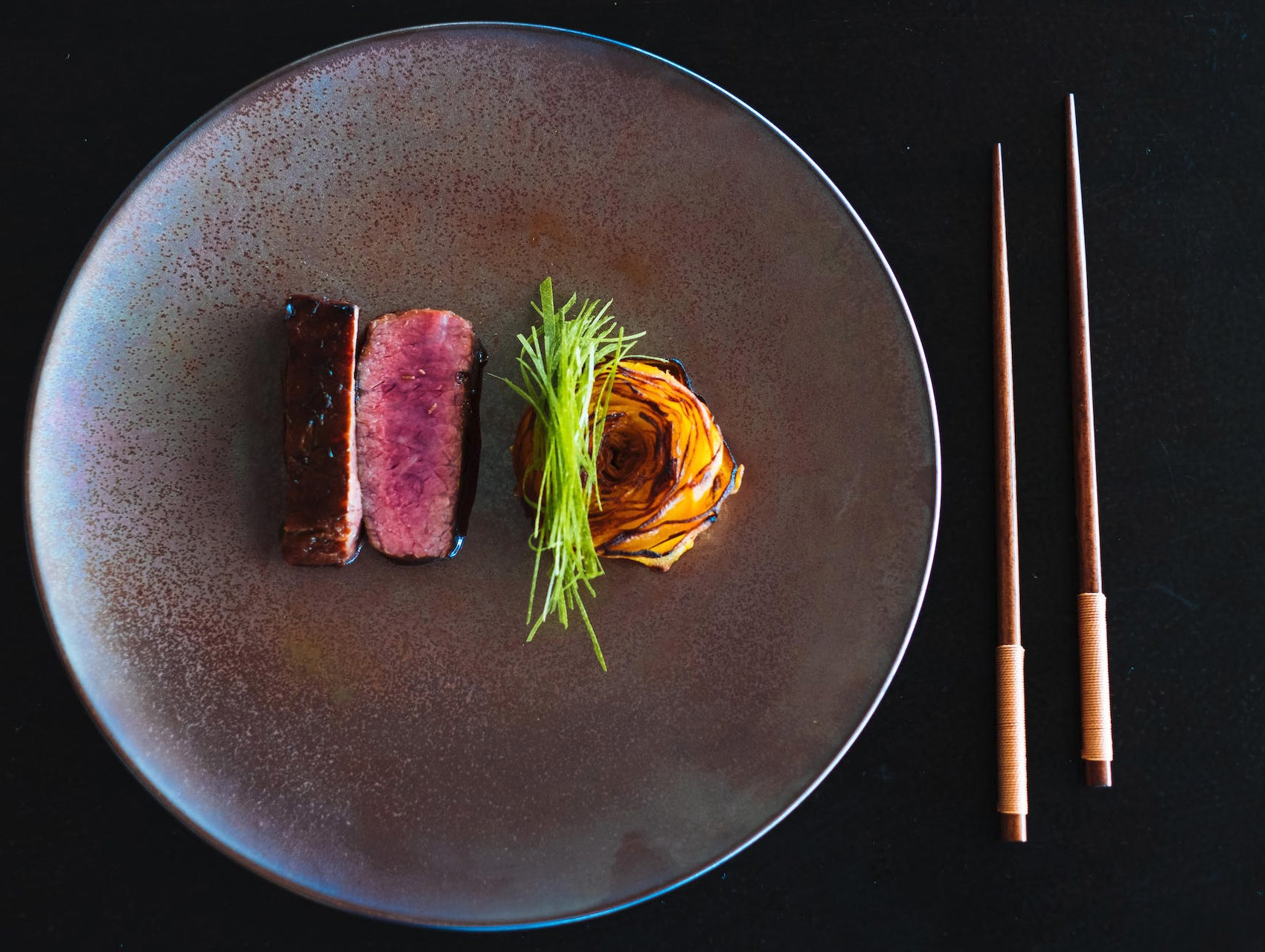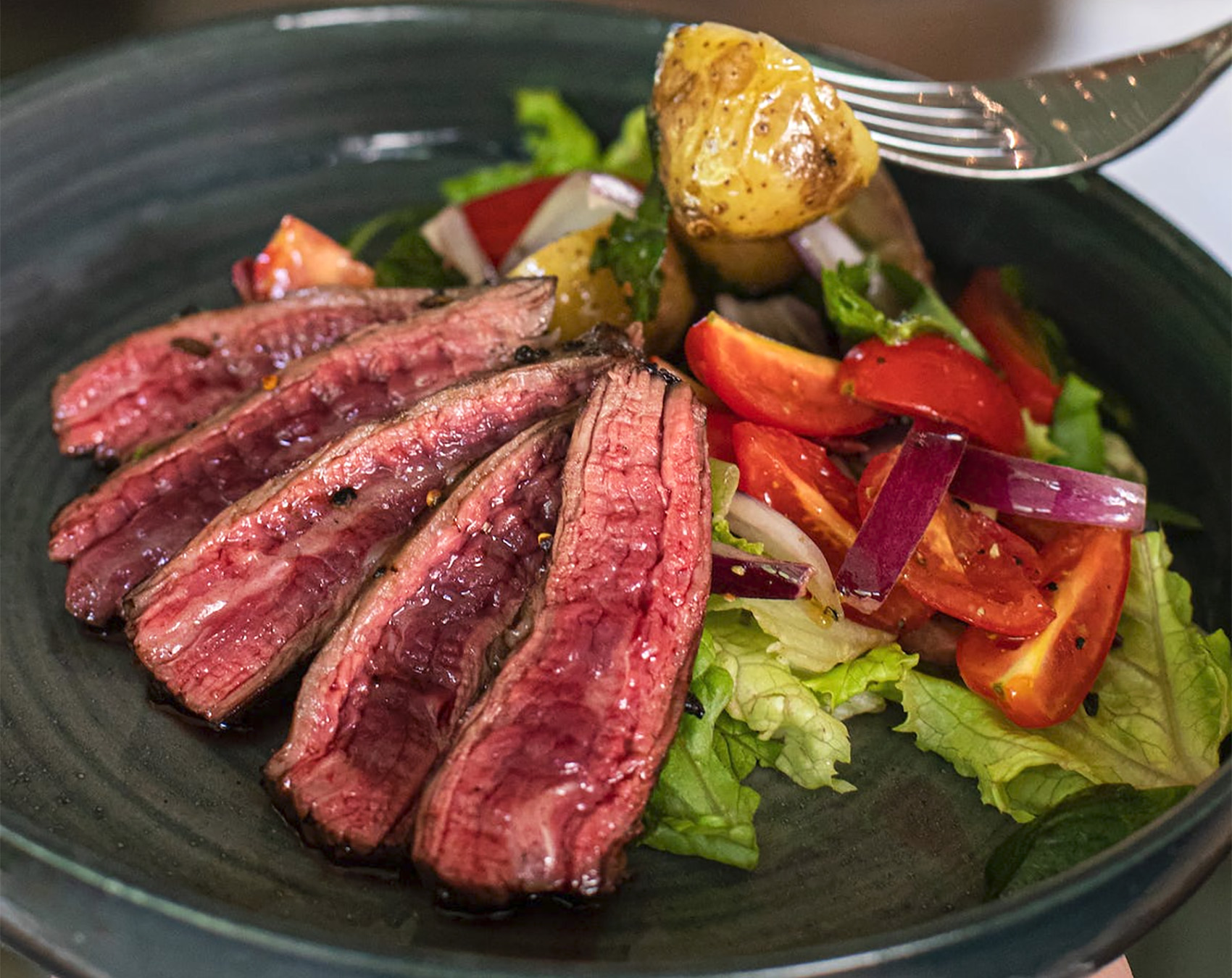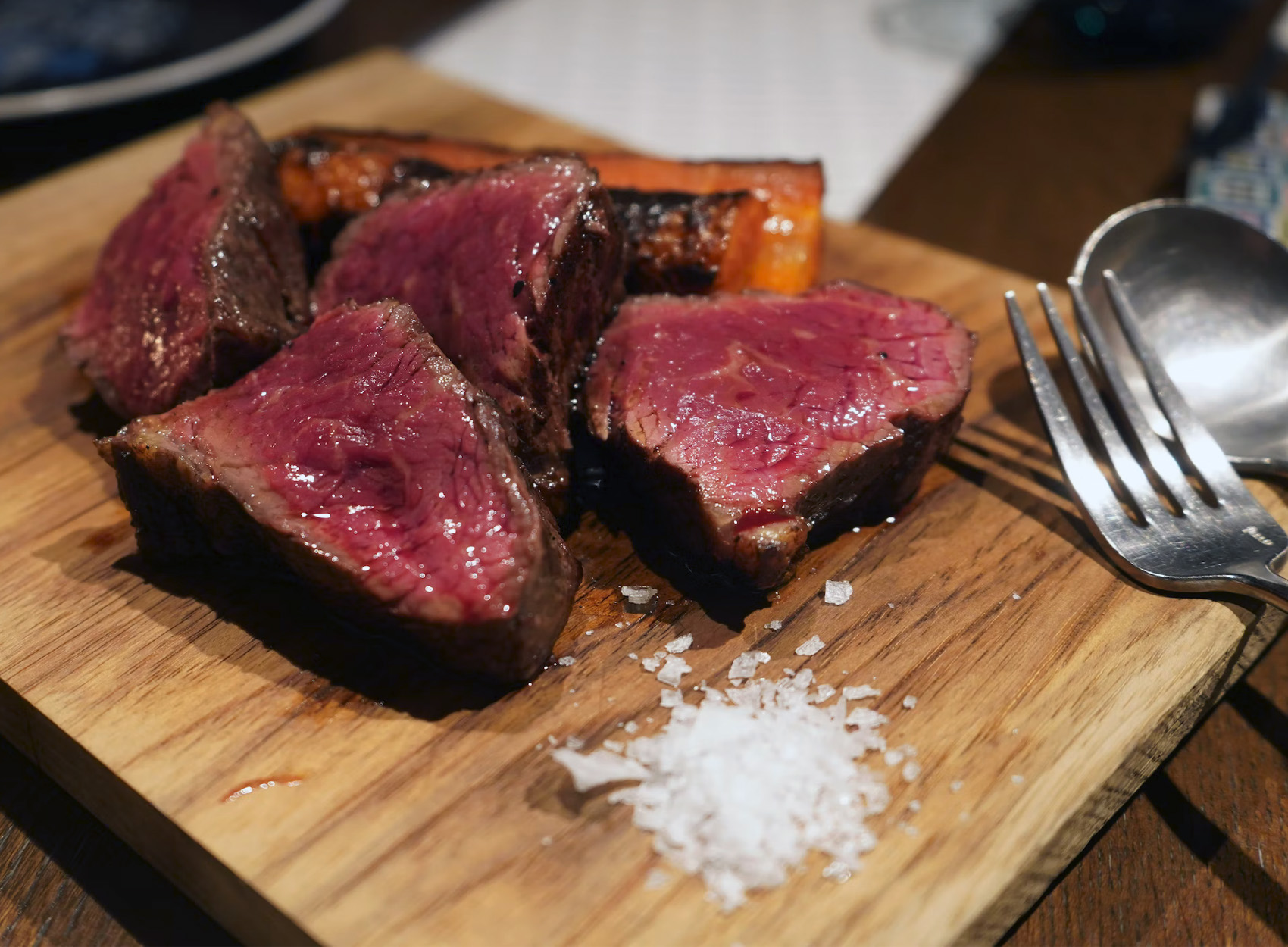What Is Blue Steak?
Blue Steak is the first stage on the steak doneness scale and has an internal temperature of between 115°F – 120°F (46°C – 48°C). It’s also known as “Blue Rare”, “Bleu”, or “Purple Rare”. The term “Blue Steak” refers to the color of the meat once it’s cooked and cut open. The outside of the steak is lightly seared for such a short time that the inside of the meat remains cool and almost raw. It was first popularized in France and named “Bleu” which refers to steak that is served so rare that it appears bluish inside. In fact, if the beef were cooked any less it would be considered raw.
Blue steak is extremely rare, once the meat is seasoned it’s lightly seared on the outside for only a minute which keeps it just a touch above raw on the inside. When you cut the meat open it will be col to the touch and a blueish color. The texture is buttery and unlike any other beef you’ve probably eaten.
When using a meat thermometer, the temperature of Blue Steak should read between 115-120° Fahrenheit. If cooked correctly, the outside should be slightly seared while the inside looks almost raw and reddish blue.
Why Do They Call It Blue Steak?
Blue Steak is lightly seared for about a minute on each side over extremely high heat until the internal temperature reaches between 115 °F and 120 °F (46°C – 48°C). The result is a steak that’s seared on the outside but cool and bluish in color on the inside. The meat is one step below rare on the steak doneness scale and almost raw.
What Internal Temperature Is Blue Steak?
Blue Steak is the first stage on the steak doneness scale and has an internal temperature of between 115°F – 120°F (46°C – 48°C). Any colder and the meat is considered raw. Any hotter and it starts to become rare.
How To Cook Blue Steak
The key to cooking Blue Steak is the sear. Each side is cooked for just one minute over extremely high heat followed by the edges. This is just long enough to sear the outside which kills any bacteria living on the surface. If you can’t sear the outside in a minute the inside will usually over cook to rare.
Reaching a high enough heat to sear beef in just a minute is not easy to do on your average stovetop or grill. Don’t try it if you can’t get your equipment hot enough to do it.
Here’s how to do it in a pan or skillet:
- Bring the steak to room temperature. If the inside of the meat is cold it will interfere with the cook time.
- Season the beef with dry seasonings like salt, pepper or a rub. Don’t use a wet marinade because it may interfere with the cook time.
- Preheat the stovetop as hot as you can get it.
- Oil the pan or skillet lightly.
- Place the steak onto the pan. It should sizzle when it hits.
- Sear each side for a minute and then the edges.
- Remove from heat and check the internal temperature with a meat thermometer. It should read 115°F – 120°F (46°C – 48°C). Any warmer and the meat may become rare as it rests.
- Let the meat rest for 5 minutes before serving.
- As an optional finishing touch, pat a little steak butter on top and let it melt into the meat as it rests.
- Serve.
If done correctly, the outside should be seared with a blueish red, cool interior that’s almost raw.
The purpose of resting a Blue Steak is to cool down the surface just enough so you don’t burn your mouth and tongue on the meat.
Blue Steak Safety Tips
Studies have shown that bacteria like E.coli are commonly found on the outside of steak. But proper cooking and handling eliminates these bacteria. The fresher the meat the less chance there is of bacteria. For this reason I recommend using only the freshest beef to cook Rare or Blue Rare.
Properly prepared Blue Steak is safe to consume, but you must follow food safety guidelines stringently.
- Use the freshest beef possible. This reduces the chance of bacterial growth on the surface.
- Always clean and sterilize your tongs, forks knives etc.
- Sterilize all surface the meat touches.
- Anything that touches the meat should be thoroughly cleaned including your hands.
- Do no puncture the meat.
- Handle the meat with tongs. Puncturing meat can introduce bacteria beneath the surface.
- Make sure the outside of the meat is completely seared over extremely high heat before serving.
- Always check the internal temperature of beef with a food thermometer before eating. It should be 115°F – 120°F (46°C – 48°C).
The safest way to eat steak is with an internal temperature of at least 140° Fahrenheit. Rare and Blue steaks are eaten all the time, but you need to be extra careful about handling them and only use the freshest meat.
Blue Steak Vs Rare
Blue Steak is the first stage on the steak doneness scale and has an internal temperature of between 115°F – 120°F (46°C – 48°C). Rare is the second stage on the doneness scale and has an internal temperature of between 125°F – 130°F (45°C – 50°C). This difference is actually pretty big because it’s achieved by cooking each side of the steak for another two to three minutes. This not only develops a thicker sear on the outside but also cooks the inside from blueish to red which creates more juices.
A rare steak’s center is around 75% red and 25% pink. However a Blue Steak is considered “extra rare” where the center is almost entirely red.
The inside of a Blue Rare Steak is cool while the inside of Rare is slightly warm to warm. The color also changes from bluish red to bright red. The texture becomes softer and more tender and the meat will be a little juicier.
Blue steaks have to be extremely lean because the fat doesn’t have time to warm up and become soft. But rare beef can be fattier with marbling because the fat has more time to cook and melt. This makes more tender and juicy steak.
In terms of flavor, both cooking methods deliver a flavorful steak. But rare is more complex because fats can melt and create juice that adds flavor to the meat. You can also cook beef with bones to rare which adds a stringer beef flavor from the marrow.
Is Blue Steak Safe To Eat?
Yes, Blue Steak is perfectly safe to eat as long as it’s cooked properly to an internal temperature of at least 115°F – 120°F (46°C – 48°C). The beef used to cook steak this raw should be extremely fresh and always handled properly to prevent cross contamination. Make sure all surfaces, knives, forks, etc. that touch the meat are washed and free of bacteria and germs. Studies have shown that bacteria like E.coli are commonly found on the outside of steak, but proper cooking and handling of beef eliminates these bacteria.
The key to cooking blue steak is the sear. Since Blue rare steak is only cooked for about a minute per side there’s not a lot of room for error. Searing kills bacteria on the outside of the meat and lightly cooks the inside. Make sure the heat is turned up extremely high or you won;t be able to sear the meat properly in just a minute.
Bacteria should not be on the inside of the meat unless you puncture it with a contaminated fork or knife so be very careful when handling beef you plan on preparing as Blue Steak.
Exposure to high temperatures on the outside will kill bacteria on the surface but the inside doesn’t get very hot. If you introduce bacteria with a contaminated utensil it may not be killed at just 115°F – 120°F (46°C – 48°C).
In addition to searing both sides of the steak you should also sear the edges to kill any bacteria that may be living there.
What Does Blue Steak Taste Like?
Blue Rare tastes like any other steak on the outside. The surface is seared and it’s flavored with coarse pepper and salt or a rub. They’re also commonly served with a sauce or cheese to dip into. But it’s the inside where the taste and texture are a little strange. The flavor will vary depending on the cut, but overall it’s a beefy flavor that should be cool but not cold with a buttery feel. If the right cut was used, the meat will be very tender and juicy.
The taste of Blue Rare isn’t that much different from beef cooked at a higher internal temperature, it’s the texture that changes the most. The meat will feel warm on the outside but cool inside which is something to get used to. The texture is soft and a bit chewy and there should be very little to no fat.
The absence of fat and marrow means less time to develop rich flavors like a steak cooked to medium.
What Texture Is Blue Steak?
The texture of Blue Steak is very different from rare, medium-rare, medium, etc. Heat makes beef more tender up to a certain point as it breaks down proteins. Past that point the meat starts to get tougher. Usually this is around the medium-rare temperature range but it varies depending on the cut.
Blue Rare isn’t hot enough to break down proteins so you’re eating the meat in its purest form. The texture is chewier than meat cooked at higher temperatures and feels cool but not cold.
Because the meat is very lean, you shouldn’t be chewing bits of fat like you do when eating a conventional steak.
The Best Cuts For Blue Steak
The best cuts for Blue Steak are Top Sirloin, Filet Mignon and Flat iron. Lean and tender cuts work best. Choose meat with the least amount of strip fat or marbling. The key to making Blue Rare Steak is fresh beef. The less time meat is sitting out after being butchered the higher the chance of bacteria. I wouldn’t freeze the meat or even keep it refrigerated for too long. Ideally you should cook the meat the same day it’s butchered.
Cooking a steak melts the fat and breaks down the meat’s marbling. When you’re cooking a Blue Rare Steak, the meat is cooked so quickly the fat doesn’t have time to melt. For this reason, lean cuts containing the least amount of fat are the best choice.
If you plan on cooking Blue Rare Steak, ask you butcher for the freshest meat they have. Preferably something cut that same day which hasn’t been sitting in a freezer or refrigerator.
Your best choices for a blue steak include:
- Top Sirloin: Cut from the sirloin subprimal, the meat is very lean, tender juicy and flavorful. This is my favorite cut for Blue Rare Steak.
- Filet Mignon: Tenderloin is a cut from the loin of the cow. It has very little fat and is extremely tender.
- Flat Iron: Cut from the chuck or shoulder area of a cow. This is the cheapest option for Blue Rare meat.
Blue Steak should be about 1-2 inches thick. If the meat is too thin, it will over-cook when the sides and edges are seared.
For example, 1 inch thick meat is very hard to cook Blue Rare because it cooks past 115°F – 120°F (46°C – 48°C) on the inside when the outside is still being seared. Any thinner than 1 inch is almost impossible.
The Worst Cuts For Blue Steak?
The worst cuts for Blue Rare are actually some of the best steaks you can eat, like Ribeye, T-Bone and Porterhouse. This is due to their fat content and marbling. Fat needs time to render and become moist which provides flavor and juices to your steak. Since cooking meat extremely rare is done quickly, any fat in the meat will be cool and very chewy.
Don’t try to cook tough and thin steaks like flank, skirt and hanger extremely rare either. Cuts like this need time to marinade which breaks down tough muscle fibers and makes them more tender. They’re also so thin that cooking for even a minute per side brings the internal temperature above 115°F – 120°F (46°C – 48°C). They taste great in a taco, sandwich or fajitas but not as a Blue Steak.
Some of the worst cuts for Blue Steak include:
- Ribeye
- Porterhouse
- T-bone
- Skirt
- Flank
- Flap
- Hanger
- Bottom sirloin
Wagyu and Kobe are usually not great for Blue Steak because they have too much marbling. However, they can be served raw as sashimi when sliced into very thin ribbons that are easy to chew.
How To Grill Blue Steak?
Blue steak can be cooked either on a grill or in a hot pan or skillet. The key is in the searing. Since you’re only cooking each side for about a minute, the heat needs to be really high.
Here’s how it’s done:
- The meat should be at room temperature before you start cooking. If it’s cool inside, you’ll have a hard time reaching the 115°F – 120°F (46°C – 48°C) requirement with just a minute sear on each side.
- Preheat your grill as hot as you possibly can.
- Season the meat.
- Brushing olive oil on the surface of your steak will help develop a thicker char.
- Once your grill is hot, place the meat onto the grate over direct heat. Leave the grill lid up.
- Leave the meat on for no more than one minute before flipping to the opposite side.
- After a minute on the second side, grip the steak with tongs and sear the edges. This is very important because it kills any bacteria living on the edges of the meat.
- Remove from heat and check it with a meat thermometer. It should have an internal temperature between 115 °F and 120 °F (46°C – 48°C). If it’s at or above 120 °F, the meat will probably become rare as it rests for 5 minutes.
- Let the meat rest for 5 minutes before serving.
- As an optional finishing touch, pat a little steak butter on top and let it melt into the meat as it rests.
- Serve.
The purpose of resting a Blue Steak is to cool down the surface just enough so you don’t burn your mouth and tongue on the meat. I recommend resting for 5 minutes, but if the meat is cool enough to eat sooner, it’s fine to do so.
What Is Black And Blue Steak?
Like a Blue Rare Steak, the inside of a Black and Blue Steak is bluish-red and almost raw. But the outside is charred rather than seared. This gives the steak a unique combination of a charred well-done outside with a cool and tender inside.
What Is Pittsburgh Blue Steak?
A Black and Blue Steak is also referred to as a “Pittsburgh Blue Steak” or a “Pittsburgh Style Steak”. The name Pittsburgh steak dates back to Pittsburgh Pennsylvania steel mills during the industrial times between 1740 and 1850. Steel mill workers would bring steaks to work and cook them atop the hot factory equipment. The equipment was so hot it would quickly char the outside of the meat while leaving the inside bluish-red and cool.
How To Cook Black And Blue Steak
Black and Blue steak should be cooked on a grill with an open flame. Lower the grate close enough so that flame ups can scorch the meat. The key to cooking Black and Blue Steak is in the charring. Since you’re only cooking each side for about a minute, the heat needs to be extremely high.
Here’s how it’s done:
- The meat should be at room temperature before you start cooking. If it’s cool inside, you’ll have a hard time reaching the 115°F – 120°F (46°C – 48°C) requirement with just a minute to charr on each side.
- Preheat your grill as hot as you possibly can.
- Season the meat.
- Cover the meat with butter or lard.
- Once your grill is red hot, place the meat onto the grate over direct heat. Leave the grill lid up.
- Leave the meat on for no more than one minute before flipping to the opposite side.
- After a minute on the second side, grip the steak with tongs and sear the edges. This is very important because it kills any bacteria living on the edges of the meat.
- Remove from heat and check it with a meat thermometer. It should have an internal temperature between 115 °F and 120 °F (46°C – 48°C). If it’s at or above 120 °F, the meat will probably become rare as it rests for 5 minutes.
- Let the meat rest for about 5 minutes before serving.
- As an optional finishing touch, pat a little steak butter on top and let it melt into the meat as it rests.
- Serve.
The melting fat and butter will cause flames to rise higher which increases the temperature. Don’t move the meat out of the flames because it helps develop a deeper char.
Summary: What Is Blue Steak?
Blue Steak is the first stage on the doneness scale and has an internal temperature of between 115°F – 120°F (46°C – 48°C). It’s also known as “Blue Rare”, “Bleu”, or “Purple Rare”. The term “Blue Steak” refers to the color of the meat once it’s cooked and cut open. The outside of the steak is lightly seared for such a short time that the inside of the meat remains cool and almost raw. It was first popularized in France and named “Bleu” which refers to steak that is served so rare that it appears bluish inside. In fact, if the beef were cooked any less it would be considered raw.
Blue steak is extremely rare, once the meat is seasoned it’s lightly seared on the outside for only a minute which keeps it just a touch above raw on the inside. When you cut the meat open it will be col to the touch and a blueish color. The texture is buttery and unlike any other beef you’ve probably eaten.
When using a meat thermometer, the temperature should read between 115-120° Fahrenheit. If cooked correctly, the outside will be slightly seared while the inside looks almost raw and reddish blue.
If you have any questions about Blue Steak, email any time.

























